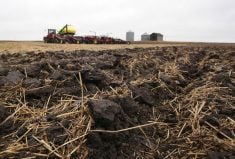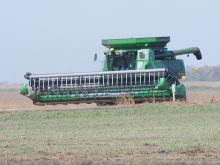Producers want to be included when feds decide how to reduce greenhouse gas emissions, particularly from fertilizer use
Wheat growers in Alberta are demanding a say in how Ottawa achieves federal greenhouse gas emissions targets in the agriculture sector, particularly when it comes to commercial fertilizer use.
At its annual general meeting held in January, the Alberta Wheat Commission passed a resolution demanding the AWC and like-minded crop commissions be included in discussions with the federal government on what absolute GHG emissions entail and how the baseline date will be set for the calculation of future reductions.
The federal government has already established a voluntary target aimed at reducing agricultural emissions related to fertilizer use by 30 percent over the next eight years.
Read Also

U.S. bill could keep out Canadian truckers
The Protecting America’s Roads Act, which was tabled in the U.S. House of Representatives at the beginning of October, would “rid the country of illegal immigrant commercial truck drivers and ineligible foreign nationals.”
Ottawa has not indicated how it intends to reach that target but some industry observers fear that the “voluntary” target could become a “mandatory mandate” achieved through regulated restrictions on farm fertilizer use.
Ottawa has not indicated whether the reduction will be achieved through an absolute 30 percent reduction in fertilizer applications, or whether the reductions can be achieved through emission reducing technologies or programs, such as the adoption of variable rate fertilizer application technologies or adherence to principles outlined in the 4R Nutrient Stewardship program.
A federal mandate requiring an absolute reduction in fertilizer use would have a “catastrophic impact” on yields and farm profitability, according to the AWC.
“I think we’re still trying to understand the government of Canada’s intent on this, as to whether or not it’s an absolute reduction (in fertilizer use) or an emissions reduction target,” said AWC general manager Tom Steve.
“So far, we haven’t had a lot of clarity on that.”
“We’ve had a lot of discussion on this topic but obviously, if farmers are required to reduce their fertilizer use by 30 percent by 2030, that would have a catastrophic impact on yields and competitiveness,” he added.
“The reason this came up (is that) a lot of producers have already adopted a lot of things like variable rate (fertilizer technologies) and what not … so if they (Ottawa) set a baseline date at 2020… it could leave a lot of producers that have already adopted new technologies out,” added Michael Bury, an Alberta wheat grower, who presented the resolution.
“(Those farmers) could be left holding the bag and (would) not be able to meet those targets.”
Last year, a report prepared by accounting firm Meyers Norris Penney suggested Canadian farmers stand to lose $48 billion in income over the next eight years if the federal government moves ahead with plans to reduce greenhouse gas emissions from on-farm fertilizer use by 30 percent.
The report, entitled Implications of a Total Emissions Reduction Target on Fertilizer, said achieving a 30 percent reduction in ag emissions through a gradual reduction in actual fertilizer use would result in annual farm income losses ranging from $1.8 billion in 2023 up to $10.4 billion in 2030.
The report was commissioned by Fertilizer Canada, an organization that represents fertilizer manufacturers, wholesale distributors and retailers.
In a subsequent interview, Fertilizer Canada president Karen Proud said achieving Ottawa’s 30 percent reduction target “would require a reduction in fertilizer use.”
“There’s no other way at this stage to achieve it,” she said.
Proud said Ottawa established its GHG reduction target without consulting affected industries and without conducting an economic analysis.
“These targets were set with absolutely no consultation whatsoever, with the agricultural sector, with the industries that support the agricultural sector or even with the provincial governments …,” she said.
In a recent address to the AWC, Alberta agriculture minister Nate Horner said the Alberta ag department is hoping for clarity in a report being prepared by the federal government.
Horner said provincial ag ministers made it clear during a recent federal-provincial agriculture policy summit that any reduction in fertilizer emissions must be achieved through technology, not at the expense of farmer profitability.
“If that’s going to be the goal, then we need to walk that way with technology and it can’t be at the expense of yield,” Horner said.
Horner said some provincial ministers who attended the recent federal-provincial ag policy meetings were frustrated by the lack of clarity on how Ottawa planned to meet its emission reduction targets.
“It was very frustrating… because it felt like they were sometimes talking out of both sides of their mouths around their broad fertilizer emissions reduction goal, but then also clearly stating that Canada is one of few jurisdictions that could create more food than it consumes and that we have an obligation to the globe to produce more food,” Horner said.
Canada’s farmers have already made significant contributions to greenhouse gas reduction, using variable rate fertilizer technology and the adoption of zero-till practices, he added.
“We’re doing a lot of these things already so a lot of the low-hanging fruit has already been plucked, so to speak.”


















